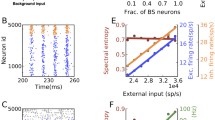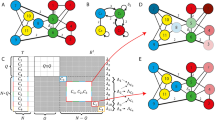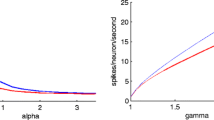Abstract
Synchronous firing of a population of neurons has been observed in many experimental preparations; in addition, various mathematical neural network models have been shown, analytically or numerically, to contain stable synchronous solutions. In order to assess the level of synchrony of a particular network over some time interval, quantitative measures of synchrony are needed. We develop here various synchrony measures which utilize only the spike times of the neurons; these measures are applicable in both experimental situations and in computer models. Using a mathematical model of the CA3 region of the hippocampus, we evaluate these synchrony measures and compare them with pictorial representations of network activity. We illustrate how synchrony is lost and synchrony measures change as heterogeneity amongst cells increases. Theoretical expected values of the synchrony measures for different categories of network solutions are derived and compared with results of simulations.
Similar content being viewed by others
References
Christiansen B, Levinsen M (1993) Collective phenomena in large populations of globally coupled relaxation oscillators. Phys Rev E 48:743–756
Daido H (1987) Scaling behavior at the onset of mutual entrainment in a population of interacting oscillators. J Phys A Math Gen 20:L629-L636
Golomb D, Rinzel J (1993) Dynamics of globally coupled conductance-based inhibitory neurons with heterogeneity. Phys Rev E 48:4810–4814
Golomb D, Rinzel J (1994) Clustering in globally coupled inhibitory neurons. Physica D 72:259–282
Hale J (1969) Ordinary differential equations. Krieger Publishing, Malabar, Fl.
Kuramoto Y (1984) Chemical oscillations, waves and turbulence. Springer, Berlin Heidelberg New York
Pinsky P (1994a) Synchrony and clustering in an excitatory neural network with intrinsic relaxation kinetics. Siam J Appl Math 55:220–241
Pinsky P (1994b) Mathematical models of hippocampal neurons and neural networks: exploiting multiple time scales. Ph.D thesis, Univ of MD, College Park
Pinsky P, Rinzel J (1994) Intrinsic and network rhythmogenesis in a reduced Traub model for CA3 neurons. J Comput Neurosci 1:39–60
Schwartzkroin P, Prince R (1978) Penicillin induced epileptiform activity in the hippocampal in-vitro preparation. Ann Neurol 1:463–469
Strogatz S, Mirollo R (1991) Stability of incoherence in a population of coupled oscillators. J Stat Phys 63:613–636
Traub R, Wong R, Miles R, Michelson H (1991) A model of a CA3 hippocampal pyramidal neuron incorporating voltage-clamp data on intrinsic conductances. J Neurophysiol 66:635–649
Traub R, Miles R, Jefferys J (1993) Synaptic and intrinsic conductances shape picrotoxin-induced synchronized afterdischarges in the guinea-pig hippocampal slice. J Physiol (Lond) 93:525–547
Author information
Authors and Affiliations
Rights and permissions
About this article
Cite this article
Pinsky, P.F., Rinzel, J. Synchrony measures for biological neural networks. Biol. Cybern. 73, 129–137 (1995). https://doi.org/10.1007/BF00204051
Received:
Accepted:
Issue Date:
DOI: https://doi.org/10.1007/BF00204051




